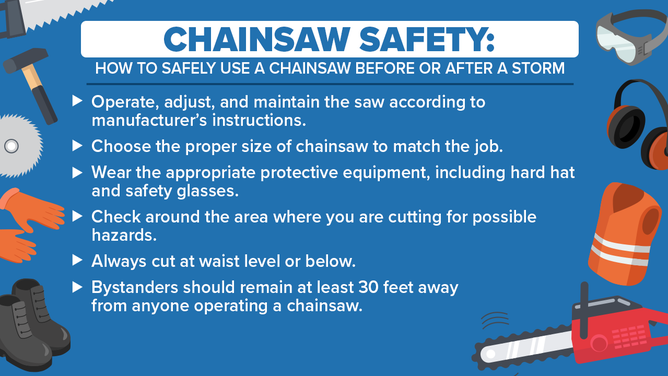How to safely use a chainsaw before or after a storm
According to the CDC, each year, approximately 36,000 people are treated in hospital emergency departments for injuries from using chainsaws.

Following a severe storm or hurricane, homeowners will be anxious to get outdoors and begin cleaning up fallen trees and broken tree limbs. Work that in many cases will require the use of a chainsaw.
Whether you have little experience or lots of experience using a chainsaw, it's always beneficial to keep a few safety practices in mind.
According to the CDC, each year, approximately 36,000 people are treated in hospital emergency departments for injuries from using chainsaws.
The potential risk of injury increases after hurricanes and other natural disasters, when chainsaws are widely used to remove fallen or partially fallen trees and tree branches.
Proper preparation is necessary to ensure that the chainsaw doesn’t mistake an arm or leg for a fallen tree. The preparation of the saw is important, but also just as important is the personal preparation of the saw handler.
Read the Owner’s Manual
Before you even attempt to clean up any type of storm debris, you should carefully study the operator’s manual so that you are thoroughly familiar with all aspects of the chainsaw.
Before you use a particular saw for the first time and periodically thereafter, you should always carefully review the owner’s manual.
Manuals offer proper operating procedures as well as detailed information about recommended maintenance practices to keep the saw running smoothly and safely.
To better protect yourself from injury when using a chainsaw to clean up storm debris, consider following these important safeguards:
- Operate, adjust, and maintain the saw according to the manufacturer’s instructions provided in the manual for the chainsaw.
- Properly sharpen chainsaw teeth and properly lubricate the blade with bar and chain oil. Additionally, periodically check and adjust the blade to keep the correct tension on the chain to keep it from coming off the blade, and ensure good cutting action.
- Choose the proper size of chainsaw to match the job, and include safety features such as a chain brake, front, and rear hand guards, stop switch, chain catcher, and a spark arrester.
- Wear the appropriate protective equipment, including a hard hat, safety glasses, hearing protection, heavy work gloves, cut-resistant legwear (chainsaw chaps) that extend from the waist to the top of the foot, and boots that cover the ankle.
- Check around the area where you are cutting for possible hazards like nails or cables, both inside the wood itself, or in debris laying around the tree or limb.
- Avoid contact with power lines until the lines are verified as being de-energized.
- Always cut at waist level or below to ensure that you maintain secure control over the chain saw.
- Clear the area of cut limbs and wood as you work to allow for safer use of the saw, and to provide an escape path in case of sudden unanticipated movement by trees and limbs.
- Bystanders or coworkers should remain at least 2 tree lengths (at least 150 feet) away from anyone felling a tree and at least 30 feet from anyone operating a chainsaw to remove limbs or a fallen tree
- If an injury occurs, apply direct pressure over site(s) of heavy bleeding; this may save lives.

A man uses a chainsaw to cut through a downed tree in Central Park in New York, on Tuesday, Oct. 30, 2012.
(Peter Foley/Bloomberg via Getty Images)
Also, take extra care in cutting "spring poles" trees or branches that have gotten bent, twisted, hung up on, or caught under another object during a high wind.
If the tree or the branch is suddenly released, it may hit the person cutting it, or a bystander, with enough force to cause serious injury or death.
Even a seemingly small tree or branch may pose a hazard when it is released from tension.
RELATED: 'Don't wait until hurricane season': Check your trees for damage before the storms hit
To avoid any potential injury, identify the maximum point of tension on the spring pole and slowly shave the underside of the tree rather than cut through to allow the tree or branch to release the tension slowly.
It is usually best to have a chainsaw operator who has training and experience in safe chainsaw use and cutting techniques to clean up storm debris for you.
Once the cutting is complete, there are some recommended steps for proper storage of the saw, beginning with stopping the engine and draining the fuel tank in a safe area.
Then, the engine should be restarted and run at idle to remove the remaining gas from the engine. The chain can then be removed and stored in a container of oil and the spark plug wire also should be disconnected to reduce the possibility of accidental starting.
Cleaning up tree damage after a storm is a very demanding job. Following these basic tips can help avoid preventable injuries to you and others.